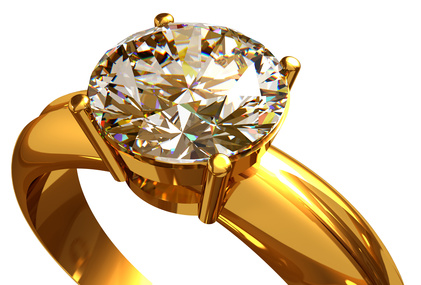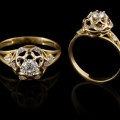What Is a Bezel Setting?
A bezel setting is a popular way to mount gemstones on rings and other jewelry. Whereas a prong setting uses small pins to hold the stone in place, a bezel setting encircles all or part of the gemstone with a strip of metal.
How Is a Bezel Setting Made?
A bezel setting consists of a metal band that encircles the stone mounted in it.
It can be made from any metal used in jewelry, but bezel-set diamonds are usually mounted in settings made of platinum or white gold.
Since the bezel (the metal band) holds the diamond along its edge, the most visible part of the stone is its top.

Diamond ring with a bezel setting
Pros and Cons of Bezel Settings
The decision whether to put a diamond or another stone in a bezel setting comes down to a tradeoff between safety and diamond/gemstone visibility.
Let’s take a look at these considerations in more detail:
Advantages
The biggest advantage of bezel settings is that they are among the safest settings you could put your diamonds or gemstones in.
The metal band surrounds the stone’s edge (which is one of the most vulnerable parts of a diamond) and protects it from accidental hits.
The setting also covers a large portion of the diamond, which would otherwise be exposed to potential damage.
Bezels hold diamonds and and gemstones much more securely than prongs, for example, and a bezel setting minimizes the possibility that your stone might fall off if you bump your piece of jewelry.
Also, unlike prong settings, bezel settings do not have parts that can stick out and get bent by snagging on your clothes or hair.
Here you can design your own diamond ring with a setting of your choice.
Disadvantages
The biggest disadvantage of bezel-set diamonds and gemstones is that a significant part of the stone is hidden in the mounting.
For this reason, some people feel that bezel settings can diminish the brilliance of diamonds by covering most of their surface and not letting light enter or come out of the concealed parts.
Bezel settings also tend to be more expensive as their construction is more complex and requires more metal than other mountings such as the prong setting.
Types of Bezel Settings: Full vs. Partial
There are two main types of bezel settings: full and partial. The main difference between them is in the degree of safety and visibility they offer for the stone.
Full Bezel Setting (also called half-bezel or semi-bezel)
Full bezels surround the edge of the mounted diamond or gemstone entirely.
The good thing about this type of setting is that the stone is fully encircled by metal and is therefore well protected.
The downside is that a lot of the diamond or gemstone remains hidden in the mounting.
Partial Bezel Setting
Partial bezel settings cover only a portion of the diamond’s/gemstone’s edge.
They are usually made from two parts, each of which surrounds about one fourth of the circumference of the stone.
Partial bezels thus leave more of the diamond/gemstone visible.
They are a good choice if you want to show as much as possible of your stone but are also concerned about its safety and don’t want to choose a prong setting because of that.
Diamonds and other transparent gemstones are good candidates for a partial bezel as this setting allows more light to enter the stone, enhancing its sparkle and brilliance.
Partial bezel settings are also preferable to full ones because the stones in them can be cleaned more easily.
The problem with partial bezel settings is that they leave part of the gemstone exposed, and that unprotected portion can chip more easily if hit.
Ultimately, the choice of a bezel setting comes down to safety vs. visibility. Go with a partial bezel if you want more visibility for your diamond/gemstone; or choose a full bezel if you’re more concerned about the safety of your stone.
Bezel Settings vs. Prong Settings
Prong settings are usually cheaper than bezel settings, making prongs a good choice if you’re on a budget. Prong settings also make the gemstone more prominent by leaving a bigger portion of it visible.
A prong setting is relatively easier to be adjusted to stones of different sizes if you ever decide to have your gemstone replaced, whereas a bezel is harder to change once it is set up.
The problem with prong settings is that they leave the stone more exposed to damage, while in a bezel setting the gemstone sits lower and is better protected.
Prong settings are also more easily damaged, and that’s why they require checking and maintenance more often.
If a prong bends or breaks, you may lose your gemstone, and for that reason, prongs need to be rebuilt after several years; bezels, on the other hand, are a lot more durable.
When to Choose a Bezel Setting
Bezel settings are a good choice for people who work with their hands a lot, in occupations where there is a higher risk of bumping or hitting your ring.
A stone held in a bezel is less likely to get loose and fall off, so this setting is a good choice for people who are very active.
If you have a gemstone that has visible defects such as prominent inclusions or chips on its side, you can have the stone set in a bezel to hide the flaws.
A bezel setting is great for softer gemstones, with hardness lower than 6-7 on the Mohs scale, as it will protect them from scratches and chips better than a prong setting would.
So, if you have a stone such as opal or turquoise, it would be better to have it set in a bezel.
Where to Buy a Ring?
For diamond, emerald, ruby, or sapphire rings, we recommend James Allen (read review) because you can take a 360-degree look at any stone before having it set in a ring.
Blue Nile is another reputable diamond retailer we recommend.















